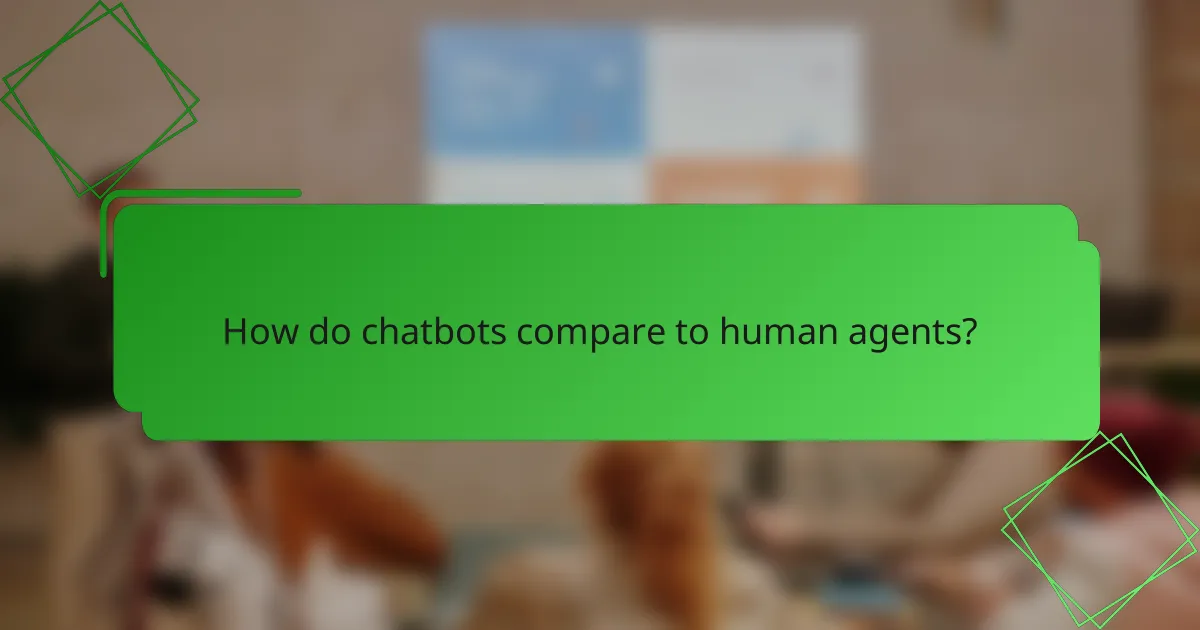Chatbots are revolutionizing customer support by delivering immediate assistance and enhancing operational efficiency. By automating responses to frequently asked questions, they allow human agents to concentrate on more complex issues, ultimately improving the overall user experience. With platforms like Zendesk Chat, Intercom, and Drift, businesses can leverage these tools to streamline their support processes and boost customer satisfaction.

How do chatbots enhance customer support in the US?
Chatbots significantly enhance customer support in the US by providing immediate assistance, improving efficiency, and ensuring a better user experience. They automate responses to common inquiries, allowing human agents to focus on more complex issues while maintaining high service standards.
24/7 availability
Chatbots offer round-the-clock availability, ensuring customers can receive support at any time, day or night. This constant access is particularly beneficial for businesses with clients across different time zones or those that operate outside of standard business hours.
By being available 24/7, chatbots can handle inquiries during peak times or off-hours, reducing wait times and enhancing customer satisfaction. This feature is crucial for industries like e-commerce, where customers may shop at any hour.
Instant response times
One of the primary advantages of chatbots is their ability to provide instant responses to customer queries. Most chatbots can reply in low tens of milliseconds, ensuring that users do not experience frustrating delays.
Quick responses help maintain customer engagement and prevent potential losses due to abandoned inquiries. For example, a customer seeking product information can receive answers immediately, facilitating quicker purchasing decisions.
Scalability for high volumes
Chatbots can efficiently handle high volumes of inquiries simultaneously, which is essential during peak shopping seasons or promotional events. Unlike human agents, who can only manage a limited number of conversations at once, chatbots can engage with thousands of customers concurrently.
This scalability allows businesses to maintain service quality without the need to hire additional staff, making chatbots a cost-effective solution for managing fluctuating demand.
Personalized interactions
Modern chatbots utilize artificial intelligence to deliver personalized interactions based on customer data and previous interactions. By analyzing user behavior and preferences, chatbots can tailor responses to meet individual needs, enhancing the overall customer experience.
For instance, a chatbot can recommend products based on a customer’s past purchases or suggest solutions based on previous support queries. This level of personalization fosters a sense of connection and loyalty among customers.

What are the benefits of using chatbots for customer support?
Chatbots offer several key benefits for customer support, including cost savings, enhanced customer satisfaction, and improved operational efficiency. By automating responses to common inquiries, businesses can streamline their support processes and provide quicker service to customers.
Cost reduction
Implementing chatbots can significantly lower customer support costs. Businesses can reduce the need for large support teams by automating responses to frequently asked questions, which can lead to savings in labor costs and training expenses.
For instance, companies may find that chatbots can handle a substantial portion of inquiries, allowing human agents to focus on more complex issues. This shift can lead to a reduction in overall operational expenses by as much as 30-50% in some cases.
Improved customer satisfaction
Chatbots enhance customer satisfaction by providing instant responses to inquiries, which meets the growing demand for quick service. Customers appreciate 24/7 availability, as they can receive assistance outside of regular business hours.
Additionally, chatbots can personalize interactions based on user data, leading to a more tailored experience. This personalization can increase customer loyalty and satisfaction ratings, often resulting in higher retention rates.
Increased efficiency
Chatbots improve operational efficiency by handling multiple inquiries simultaneously, which human agents cannot do. This capability allows businesses to manage higher volumes of customer interactions without a proportional increase in resources.
Moreover, chatbots can gather data and insights from customer interactions, helping businesses identify trends and areas for improvement. By analyzing this data, companies can refine their support strategies and enhance overall service delivery.

Which chatbot platforms are best for customer support?
Several chatbot platforms excel in customer support by enhancing automation, efficiency, and user experience. The best options typically include Zendesk Chat, Intercom, and Drift, each offering unique features tailored to different business needs.
Zendesk Chat
Zendesk Chat is a robust platform that integrates seamlessly with the Zendesk customer service suite. It allows businesses to engage with customers in real-time, providing instant responses to inquiries and reducing wait times.
Key features include customizable chat widgets, automated responses, and detailed analytics. Companies can leverage these tools to improve customer satisfaction and streamline support processes.
Intercom
Intercom focuses on personalized customer interactions, using targeted messaging and chatbots to enhance user engagement. This platform is particularly effective for businesses looking to foster relationships through proactive communication.
Intercom offers features like automated onboarding messages and user segmentation, which help tailor the support experience. Businesses can benefit from its integration capabilities with other tools, making it a versatile choice for customer support.
Drift
Drift is designed to facilitate real-time conversations between businesses and customers, emphasizing lead generation and sales support. Its chatbots can qualify leads and schedule meetings, making it a valuable tool for sales teams.
With features like live chat, automated responses, and integration with CRM systems, Drift enhances the efficiency of customer interactions. Companies should consider its focus on conversational marketing when evaluating their support strategies.

How to implement chatbots in customer support?
Implementing chatbots in customer support involves several key steps to ensure they effectively enhance service quality and efficiency. By defining objectives, selecting the right platform, integrating with existing systems, and training the chatbot, businesses can create a seamless experience for users.
Define objectives
Clearly defining objectives is crucial for the successful implementation of chatbots in customer support. Determine what you want to achieve, such as reducing response times, increasing customer satisfaction, or handling a specific volume of inquiries.
Consider setting measurable goals, like aiming for a 30% reduction in average response time or resolving 70% of queries without human intervention. This clarity will guide the entire implementation process.
Select a platform
Choosing the right platform for your chatbot is essential to meet your defined objectives. Evaluate various chatbot solutions based on factors like ease of use, scalability, and integration capabilities with your existing systems.
Popular platforms include Zendesk, Intercom, and Drift, each offering unique features. Assess your budget and the specific functionalities required to ensure the selected platform aligns with your customer support strategy.
Integrate with existing systems
Integrating the chatbot with your existing customer support systems is vital for a smooth operation. This includes connecting it to your CRM, ticketing systems, and knowledge bases to provide accurate and relevant responses.
Ensure that the integration allows for seamless data flow, enabling the chatbot to access customer information and past interactions. This will enhance the user experience and improve the chatbot’s effectiveness in resolving issues.
Train the chatbot
Training the chatbot is a critical step to ensure it understands and responds accurately to customer inquiries. Start by feeding it a variety of common questions and scenarios based on historical customer interactions.
Regularly update the training data to reflect new products, services, or changes in customer behavior. Monitor its performance and gather feedback to continuously improve its responses and capabilities, aiming for a high level of accuracy and user satisfaction.

What are the challenges of using chatbots for customer support?
Chatbots for customer support face several challenges that can impact their effectiveness. These include understanding complex queries, maintaining a human touch, and addressing data privacy concerns.
Understanding complex queries
Chatbots often struggle with complex or nuanced customer inquiries. While they can handle straightforward questions effectively, intricate issues may require human intervention for resolution. For instance, a customer asking about a multi-faceted billing issue might receive an inadequate response from a chatbot.
To improve performance, businesses should regularly update the chatbot’s knowledge base and incorporate natural language processing (NLP) capabilities. This allows the chatbot to better interpret varied customer language and intent.
Maintaining human touch
One significant challenge is ensuring that the interaction feels personal and empathetic. Customers often prefer speaking with a human representative, especially when dealing with sensitive issues. A chatbot’s mechanical responses can sometimes alienate users, leading to frustration.
To mitigate this, companies can implement a hybrid model where chatbots handle initial queries and seamlessly transfer complex cases to human agents. This approach combines efficiency with the necessary human touch.
Data privacy concerns
Data privacy is a critical issue when using chatbots for customer support. Customers may be hesitant to share personal information with a bot, fearing data breaches or misuse. Compliance with regulations such as GDPR in Europe or CCPA in California is essential for maintaining trust.
Organizations should ensure that their chatbots are designed with robust security measures and transparent data handling practices. Clearly communicating how customer data is used and protected can help alleviate privacy concerns and foster user confidence.

How do chatbots compare to human agents?
Chatbots offer a different approach to customer support compared to human agents, focusing on automation and efficiency. While chatbots can handle a high volume of inquiries quickly, human agents excel in providing personalized and nuanced responses.
Efficiency and Speed
Chatbots are designed to respond to customer queries almost instantly, often within a few seconds. This rapid response time can significantly reduce wait times for customers, enhancing their overall experience. In contrast, human agents may take longer to respond, especially during peak hours.
For example, a chatbot can handle multiple conversations simultaneously, while a human agent typically manages one at a time. This capability allows businesses to scale their support without proportionally increasing staff, making chatbots a cost-effective solution.
Complexity of Queries
Chatbots are best suited for handling straightforward inquiries, such as FAQs or order tracking. They can efficiently manage repetitive tasks and provide quick answers based on pre-defined scripts. However, when faced with complex or unique issues, human agents are often necessary to provide the empathy and critical thinking required.
For instance, a customer may have a specific problem that requires a detailed understanding of the product or service, which a chatbot may not be equipped to handle. In such cases, transferring the conversation to a human agent can ensure a satisfactory resolution.
User Experience
The user experience can vary significantly between chatbots and human agents. Many customers appreciate the speed of chatbots but may feel frustrated if their issues are too complex for automated responses. A well-designed chatbot can enhance user experience by providing quick solutions, but it should also have a clear escalation process to human agents when needed.
To improve user experience, businesses should ensure that chatbots are programmed with natural language processing capabilities, allowing them to understand and respond to customer inquiries more effectively. Additionally, offering an easy way to switch to a human agent can help maintain customer satisfaction.


